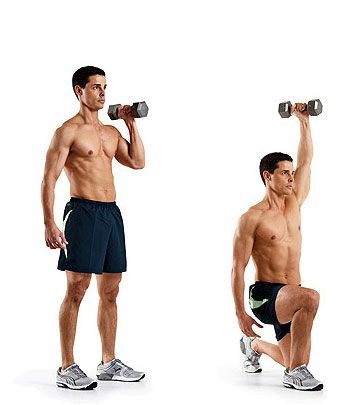Yes, the headline of this story should probably be “10 Genius Exercises You MIGHT Not Be Doing.” But frankly, that just doesn’t sound as good as the current title. (Imagine that: truth on the Internet!)
And more importantly, it doesn’t take away from the actual point: These ARE genius exercises.
You may have seen some of these movements before and simply ignored them. Or tried a couple, only to forget them. Others may be completely new to you. But all are worth working into your workout. Read on to find out why.
And for 407 more exercises like these—and more than two dozen workouts—check out The Men's Health Little Book of Exercises, available everywhere books are sold. It’s the ultimate encyclopedia of exercises in an incredibly compact book you can take anywhere.
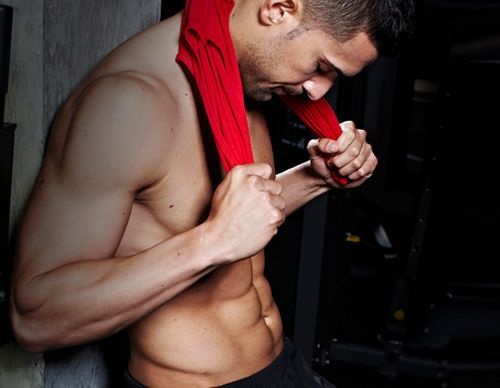
1. Staggered Hands Pushup
This exercise has been around almost as long as the traditional pushup. But staggering your hands increases the challenge to your core, and to your chest, shoulder, and arm muscles on one side. The further in front of you body you place your hand, the greater the challenge.
Use it: Do as many repetitions as you can in 20 seconds with your left hand forward, then do as many reps as you can in 20 seconds with your right hand forward. Without resting, do as many traditional pushups as you can.
How to do it: Assume a pushup position, but place one hand in standard pushup position and your other hand a few inches farther forward. Your body should form a straight line from your ankles to your head (A). Lower your body until your chest nearly touches the floor (B). Pause at the bottom, and then push yourself back to the starting position as quickly as possible.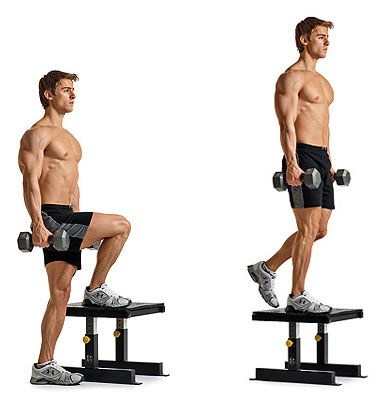
2. Crossover Dumbbell Stepup
When we implemented this at our company gym, it became a favorite for anyone interested in working their glutes. You’ll feel it there the next day.
Use it: Each rep, lower slow and control back all the way back to the floor. Then push into your heel to power back up—without rocking back and forth. Do 3 sets of 8 reps, resting 90 to 120 seconds between sets.
How to do it: Grab a pair of dumbbells and stand with your left side next to a step. Place your right foot on the step (A). (It should cross over your left leg.) Press your right foot into the bench and push your body up until both legs are straight. Lower your body back down to the starting position. Complete the prescribed number of reps with your right leg, then do the same number with your left leg.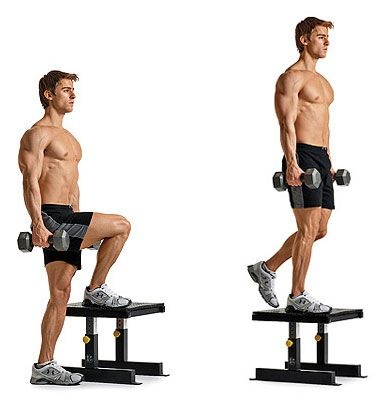
3. Standing Supported Single-Arm Underhand-Grip Row
This is a great, solid position from which to row— a movement that targets your upper and middle back. Plus, the underhand grip will allow your biceps to get in on the fun, too—and who doesn’t like that?
Use it: Do 3 sets of 8 to 10 reps with each arm. Make sure to avoid letting your torso rotate as you row the weight.
How to do it: Grab a dumbbell with your right hand using underhand grip (palm facing forward). Place your left hand on a bench in front of you and bend over at the hips. Let the dumbbell hang at arm's length, your palm facing forward. Bend your knees slightly and keep your back naturally arched with your torso parallel to the floor (A). Keeping your elbow next to your side, row the weight to the side of your torso (B). Pause, then slowly lower the dumbbell back to the starting position.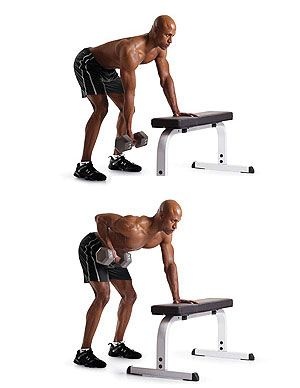
4. Prisoner Squat
Bodyweight squats are all the rage these days, but this version is often forgotten about. By putting your hands in the “prisoner” position—and pulling your elbows back—you activate the muscles of your upper back. This promotes better posture, and doubles as an isometric upper back exercise.
Use it: Try this “isodynamic” technique. Lower into the prisoner squat and hold the down position for 30 seconds. Then immediately do as many reps of the prisoner squat as you can for the next 30 seconds—while keeping your elbows pulled back and your chest out. Rest for 1 minute, and repeat 1 to 2 times.
How to do it: Stand as tall as you can with your feet spread shoulder-width apart. Place your fingers on the back of your head (as if you had just been arrested). Pull your elbows and shoulders back, and stick your chest up and out (A). Keeping your torso as upright as possible, lower your body as far as you can by pushing your hips back and bending your knees (B). Push yourself back to the starting position and repeat.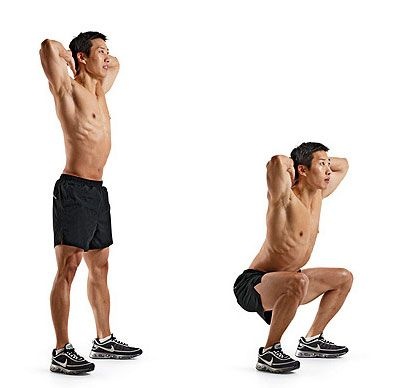
5. Cable Face Pull with External Rotation
According to a survey of top Men’s Health fitness advisers, this is one of the best exercises you can do. It simultaneously targets your upper back’s scapular muscles and the rotator cuff muscles of your shoulders. Collectively, these tend muscles, which tend to be weak in most people, are the key to healthy, stable shoulders.
Use it: Do 3 sets of 10 to 12 repetitions. You won’t be able to super heavy on this exercise, but use a weight that allows you to complete the movement through your deepest range of motion.
How to do it: Attach a rope to the high pulley of a cable station (or a lat pulldown) and grab an end with each hand, your palms facing each other. Back a few steps away from the weight stack until your arms are straight in front of you, feeling tension in the cable (A). Flare your elbows out, bend your arms, and pull the middle of the rope toward your eyes so your hands end up in line with your ears (B). Pause, then reverse back to the starting position.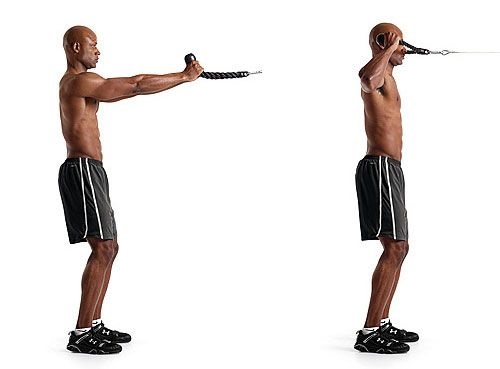
6. Side Plank with Feet on Bench
When people get bored of the side plank, they often move on to more complicated versions that have you only using one leg or that require equipment. (You can find a half a dozen more in The Men's Health Little Book of Exercises.) But that’s not the only way to progress. You can make this exercise harder simply by elevating your feet on a bench, box, or even a couch.
Use it: Don’t move to this exercise until you can hold a traditional side plank for at least 30 seconds. Focus on tension: You want to squeeze your glutes, thighs, and ankles together, and brace your core. You can try to hold for 30 seconds, or do brief holds of 10 seconds while generating as much tension throughout your body as you can.
How to do it: Place both of your feet on a bench, and lie on your left side with your knees straight. Prop your upper body up on your left elbow and forearm, with your elbow under your shoulder. Now brace your core by tightening your abs forcefully. Raise your hips until your body forms a straight line from your ankles to your shoulders. Inhale and exhale deeply and forcefully for the duration of the exercise. Once you’ve completed that set, turn around so that you're lying on your right side and repeat.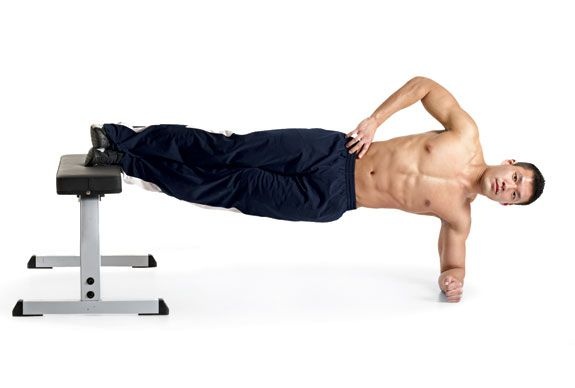
7. Single-Arm Dumbbell Shoulder Press
Because using just one dumbbell causes uneven weight distribution across your body, this exercise increases the challenge to your core, making those muscles work harder to keep you balanced. And, of course, it’s a great way to improve your shoulder strength.
Use it: Do 6 to 8 repetitions with one arm, and then repeat with the other. Rest for 2 minutes, and repeat one to two more times. To make it even more challenging, start by holding the dumbbell so that your palm is next to and facing your chest. As you press the weight up, rotate your forearm outward so that your palm is facing in front of you at the top of the movement. Note: If you have to lean backward—so that your lower back arches more—to push the weight over head, skip this exercise and focus on the next one on this list: thoracic rotation.
How to do it: Stand holding a dumbbell just outside your shoulder, with your arm bent and palm facing inward. Let your free hand hang to your side or place it on your hip. Set your feet shoulder-width apart, and brace your core (A). Press the weight upward until your arm is completely straight (B). Slowly lower the dumbbells back to the starting position. Complete the prescribed number of reps with your right arm, then immediately do the same number with your left arm.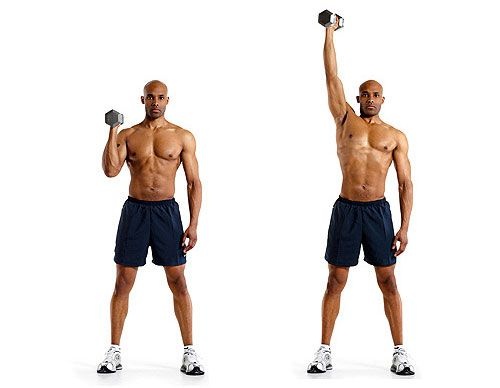
8. Thoracic Rotation
This movement helps to improve the mobility of your thoracic spine—a.k.a. your upper back. If you work at a computer or spend a lot of time slumped over your phone, you probably need this movement in a serious way. It’ll help improve your posture, and reduce your risk of a painful shoulder injury. Plus, if you have to bend backwards—over-extending your lumbar spine—to lift weights above your head, you’re compensating for poor upper mobility. And that puts you at risk for a lower back injury. The thoracic rotation can help.
Use it: Do 10 reps on each side, every day. And if you have time, make that twice a day. One key: The movement should take place at your upper back, not your lower back. Brace core by tightening your midsection to avoid moving at your lumbar spine. Or try this trick: Place a foam roller on the back of your calves, just above your ankles. Now sit back on it and stay that way as you perform the exercise. This automatically restricts the movement of your lower back.
How to do it: Get down on all fours. Place your right hand behind your head, and brace your core. Rotate your upper back downward so your elbow is pointed down and to your left (A). Raise your right elbow toward the ceiling by rotating your head and upper back up and to the right as far as possible. Complete the prescribed number of reps, then do the same number on your left.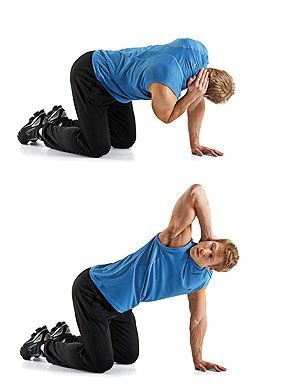
9. Barbell Curl
It’s probably laughable to a lot of you that this exercise is on the list. But many people have discarded it for more “functional” exercises. If you’re one of those folks, you might want to take another look. While the barbell curl is an “arm” exercise, it requires serious shoulder and upper back strength and stability—at least if you ever want to move serious weight. Plus, it even works your core.
Use it: Do 6 to 10 reps, resting 1 to 2 minutes between sets. One reason you might want to pass on this exercise: It can be tough on your wrists. If that’s the case, use the EZ-bar version of the exercise, which will provide many of the same benefits.
How to do it: Grab a barbell with an underhand, shoulder-width grip, and let it hang at arm's length in front your hips. Stand tall with your feet shoulder-width apart. Your arms should be completely straight, palms facing forward (A). Keeping your upper arms nearly still (they’ll move a little), bend your elbows and curl the bar as high as you can. Pause, then slowly lower the weight back to the starting position.
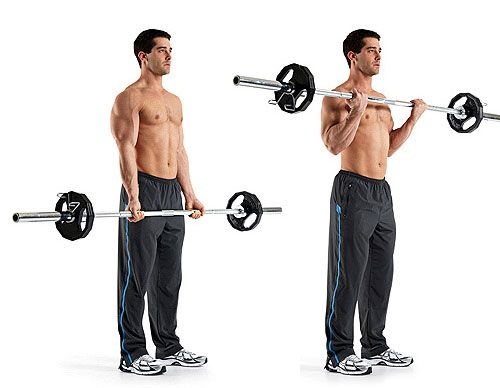
10. Single-Arm Reverse Lunge and Press
If you’re fan of total-body training, you’re going to love this exercise. It’ll give you a terrific shoulder, core, and lower-body challenge. Just make sure to use enough weight: You’ll most likely be limited by the amount you can press over your head.
Use it: Do 12 repetitions with one arm and leg, and then 12 repetitions with the other. Rest for 90 seconds and repeat two more times. Use a heavy enough weight and it’ll be a terrific shoulder, core, and lower-body work out. What’s more, if you ever thought weight training couldn’t be a great cardiovascular workout, this little routine will probably change your mind instantly (And to change your workout for the better, check out The Men's Health Little Book of Exercises, where you’ll find more than 400 more exercises, complete with full color photographs.)
How to do it: Grab a dumbbell with your left hand, and hold it next to your left shoulder, your palm facing in (A). Step backward with your left leg and lower your body into a reverse lunge as you simultaneously press the dumbbell straight above your shoulder (B). To return to the starting position, lower the dumbbell as you push yourself back up. That's one rep. Complete all your reps, then switch arms and legs and repeat.
